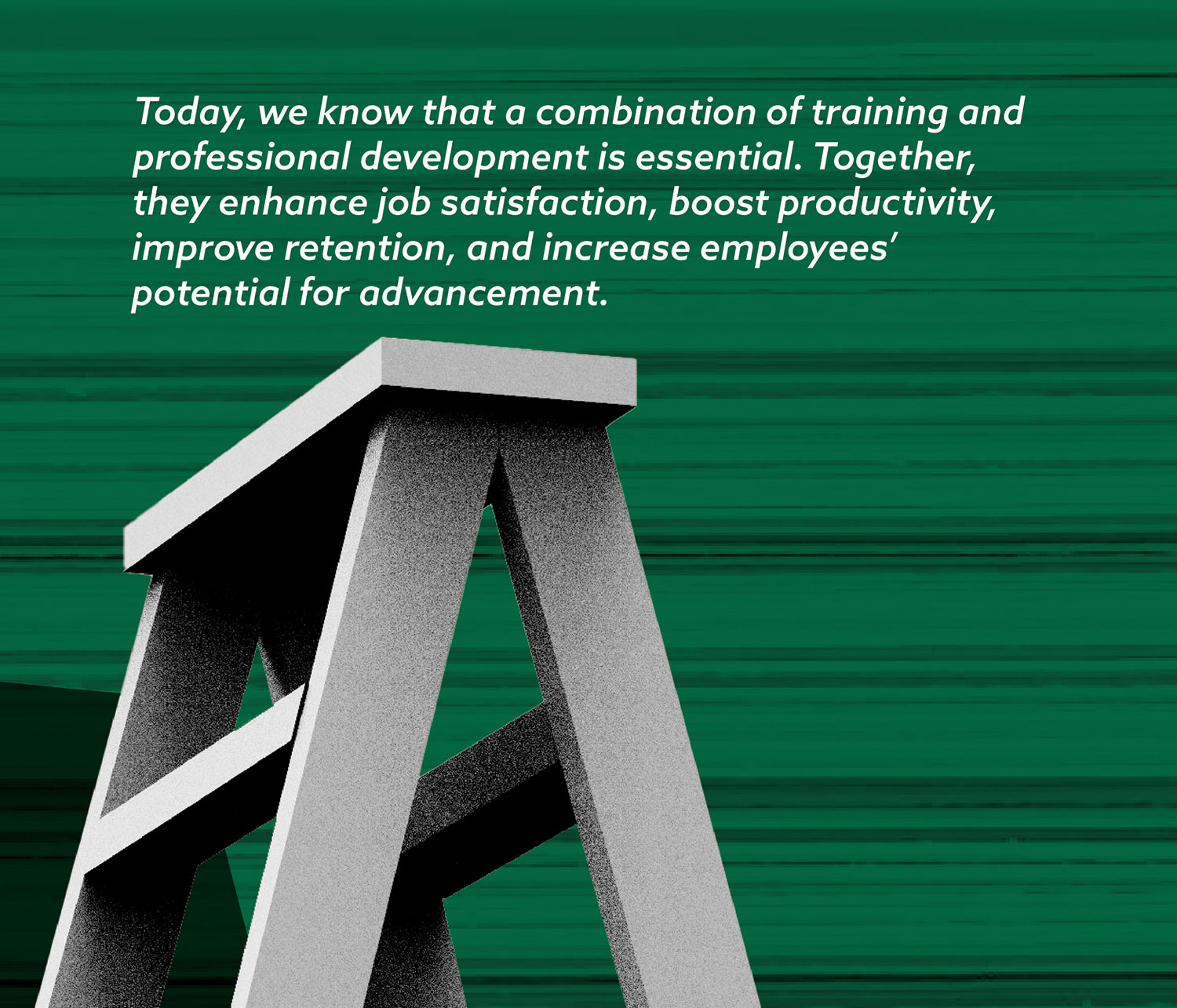CONTRIBUTORS
DOUGLAS DELL
Vice President, Executive Leader, Learning and Development, Sedgwick
ANDREA FREGONA
Director of Technical Training and Development, Germany, Sedgwick
SUZANNE McTEAGUE
Vice President of Client Services, Sedgwick
We’ve all heard the age-old proverb: “Give a person a fish and you feed them for a day; teach a person to fish and you feed them for a lifetime.” Applying this wisdom to today’s rapidly changing workplace environment, it has never been more critical for employers to develop their employees’ skills to meet the needs of their jobs — for today, tomorrow and long into the future.
The rise of distributed teams, rapid technology advancements and shifting values of younger generations have put the spotlight on retention strategies, with training and development being both necessary for an employer to thrive and demanded by employees. Here, we share the top trends and employer best practices that we’re seeing impact the training and development space.
Why both training and development are critical
Training generally focuses on the short term and provides an employee with technical skills and tools to perform a specific job. Professional development, on the other hand, is more future-focused and supports employees’ career growth goals.
Training has always been a necessary component of organizational success, with professional development often treated as a nice-to-have benefit. Today, we know that a combination of training and professional development is essential. Together, they enhance job satisfaction, boost productivity, improve retention, and increase employees’ potential for advancement. In other words, it’s a win-win combination for the employer and employee. Let’s examine what’s behind this shift.
the demand for more training and development
- Rising turnover makes talent retention critical
Spending one’s entire career with a single employer is largely a thing of the past. Employees today are much more mobile. According to one report, over half of employers (51%) experienced a turnover rate of at least 15% in 2022, up three points from 48% in 2021. Couple that with the high cost to replace an employee (estimated at 33% of their annual salary), plus lost productivity and knowledge and time dedicated to onboarding someone new, and you can see (and feel) the financial impact to an employer.Many industries are feeling this crunch, including the insurance sector. The U.S. market alone is expected to lose around 400,000 workers by 2026, according to Insurance Business, due to an aging workforce and broader talent shortages. This trend is driving employers to find ways to transfer knowledge and skills to younger employees, upskill and reskill a wider talent pool, and foster retention strategies.This is where training and professional development programs can shine, creating a win-win scenario. According to a LinkedIn workplace learning report, the No. 1 way to improve retention is by “providing learning opportunities.” The survey found that three of the top five factors people consider when pursuing new jobs reflect their desire to stretch, grow, and develop new skills. From the employer perspective, the need to train and develop is there and employees are demanding it.
- Younger workers crave growth
One of the biggest shifts is the higher importance younger generations place on training and development. According to Training Industry, Gen Z consistently rates skills development alongside compensation among their most important factors in choosing a job. Research also shows that millennials (now comprising the largest generation in the workforce) who are satisfied with their development and mentorship opportunities at work are twice as likely to stay with an organization than those who are unsatisfied. Given that Gen Z and millennials are often quicker to job-hop than their older counterparts in the workforce, company engagement is even more important.Regrettably, we’re also seeing fewer people drawn to careers in the insurance field. Early- and mid-career workers are not as interested in insurance as they once were, with many attributing this to an outdated perception of the industry as slow-moving and resistant to innovation. To be more competitive and attractive to younger generations, employers must showcase how sophisticated technologies, like machine learning, artificial intelligence (AI) and data science, are revolutionizing the insurance sector, while also demonstrating their commitment to employees’ career growth. - Remote and hybrid work requires connectivity and soft skills
While in-office remains the primary workplace arrangement, we continue to see a shift toward more flexible models. In 2023, 12.7% of full-time employees worked from home, while 28.2% followed a hybrid model, according to Upwork. Plus, the company predicts that remote work will continue to grow, with 32.6 million Americans (22%) expected to work outside an office by 2025.Professional development can provide a path for remote and hybrid employees to connect and build their networks — ultimately helping them feel a stronger sense of belonging to the organization and their colleagues. Companies are also putting greater emphasis on soft skills development, including active listening, collaboration and problem solving, to help employees work effectively outside the office. These skills build emotional intelligence, contribute to more effective communication and stronger interpersonal relationships, and improve overall job performance. - Rapid technology changes are altering jobs
The World Economic Forum predicts that technology will transform 1.1 billion jobs over the next decade, with AI and machine learning behind many of these changes. Some of today’s jobs could look different or become obsolete in the future, and some jobs that we haven’t dreamt up yet will become necessary. This is fueling a new urgency behind upskilling and reskilling employees.In the insurance industry, we’re seeing the profound impact of AI and other technological advances on automating simpler aspects of the claims process and shifting employees’ focus to more complex ones. This requires greater expertise. People skills, like creative problem solving and empathetic communication, will be more important than ever as technology absorbs routine claims tasks.In response, employers are upskilling to enhance employees’ existing skills and build a stronger talent bench. Doing so not only benefits productivity, but also engages employees by demonstrating the organization’s commitment to their personal growth and development.

How employers SHOULD respond
There are many ways to make training and development a priority. Below are some best practices that can make a strong impact.
Foster a growth-minded culture
One-size-fits-all models no longer work. Employers must demonstrate their care and commitment to the development journey of each of their people. Here are some considerations:
- Professional development should be a priority with top-down leadership support for strong execution. Employers should encourage people to take an active role in their own development while holding leaders accountable for developing their teams.
- Managers should work with their team members to develop individualized growth plans to chart each employee’s goals and the skills they need to advance. Certification and designation programs and courses for building soft skills all provide ways to help employees develop new areas of expertise while validating the company’s commitment to their growth.
- Rotational leadership programs are another way to create a structured path upward. Identify up-and-coming leaders and offer cross-departmental training for a set period of time so employees can learn all angles of the business and gain added visibility among a variety of leaders. Such programs can also grow bench strength and develop the next generation of leadership.
- Tried and true mentorship programs cultivate and empower emerging leaders, helping them feel more supported and connected to the organization. Serving as a mentor should be a widespread expectation, not confined to a few. Get creative; mentors don’t need to be within the same department. Consider instead the person’s interests, professional goals and learning needs.
Stay flexible to meet current workplace needs
Gone are the days when employers and employees viewed training as an in-person, full-week (or longer) engagement. Movement away from the classroom toward online and hybrid learning models has become the norm, alleviating employers’ cost factors and helping trainees manage personal responsibilities at home. Here are a couple of ways that companies stay flexible and effective:
- Leveraging technology, like video conferencing and e-learning platforms, can be valuable — but so is not over-relying on it. In the insurance industry, for example, we see a strong need for experiential, hands-on training. Learning by doing allows employees to apply their knowledge in real-life experiences and gain instant feedback. For instance, a new employee training for a roofing certification may spend time in a virtual classroom and then attend a live demonstration of a roof inspection alongside a trainer. A claims adjuster may simulate the management of both straightforward and complex claims to learn the requisite processes and receive feedback from expert trainers.
- In online learning classrooms, employers should create opportunities for engagement and interaction. This can be achieved through small group breakouts, which may be more conducive to facilitating conversations and connection. We’ve also found that polling engages employees while providing a continual feedback loop for trainers to determine whether a topic needs to be revisited. A dedicated live-chat channel can be incorporated for additional connectivity.

Train up in communication for remote workers
Building human connection in an increasingly remote world is critical to employee engagement, satisfaction and productivity. We’re seeing a rise in demand and need for communication skills training, such as helping employees with active listening, delivering compelling presentations over video calls, and having critical conversations remotely. With so many transactions now conducted smoothly online, live customer service experiences are often reserved for more complex situations — making soft skills development vital for employees to effectively support vulnerable customers and handle sensitive situations.
We’ve also seen an increase in training to help leaders successfully manage remote teams and maintain a positive remote culture. Skills development is being offered around virtual communication, remote team-building and digital wellness. Managers must be proactive and intentional about cultivating rapport with team members. Actively investing energy, time and resources in bringing teams together will yield benefits for the organization and give employees a stronger sense of connection.
Test and learn
A measurement plan and ongoing evaluation of strategies are essential. What works for one organization may not work for another. Within your training and development framework, incorporate quantitative measurements on attendance and course completion, along with qualitative measures like course satisfaction and engagement levels. Track this data over time to build a picture of what’s working, what’s not, and how to make your training and development program stronger. Be flexible to change, and don’t be afraid to pivot.
Critical for today and tomorrow
Today’s workers are serious about their career paths and job satisfaction. They view learning programs as a way to build a strong foundation for both. Offering a robust training and development program is no longer an employer nice-to-have. Data shows that employees prioritize learning and development as a central part of their careers, and they’re willing to leave their position to find it. Organizational leaders must prioritize growth in order to retain talent, remain competitive, and succeed in an ever-evolving economic environment.

